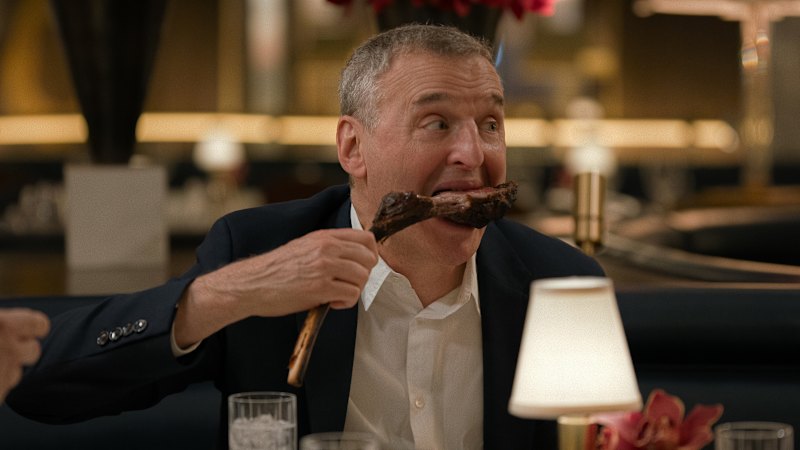
Normal text sizeLarger text sizeVery large text size
When Phil Rosenthal, host of the Netflix food and travel show, Somebody Feed Phil, and creator of the enduring sitcom, Everybody Loves Raymond, began selling out live shows last year, no one was more surprised than Ray Romano.
Romano, the sitcom’s star, showed up at the Paramount concert hall on Long Island, New York, expecting to stir up excitement among fans and help out during the Q&A. No one had a question for him, he said; they just wanted to tell Rosenthal about their favourite places to eat in Lisbon, Portugal, or Nashville, Tennessee.
Phil Rosenthal (centre) with Everybody Loves Raymond co-stars Ray Romano (left) and Brad Garrett in Somebody Feed Phil.
“How did this happen?” the actor asked me over the phone last week. “I’ve been doing stand-up for 30 years. He goes to Poland and eats meatloaf and sells out theatres around the world?”
Loading
There is no shortage of armchair-travel television. But somehow, Rosenthal has broken through and become a global star.
Season eight of his show, which features Sydney and Adelaide, dropped in June, making it one of the longest-running unscripted shows on Netflix. In August, he’ll start a North American tour, and a second cookbook, Phil’s Favourites – the first was a New York Times bestseller – will come out in November.
The live shows Rosenthal did last year sold out not only in New York City and Los Angeles, but also in Melbourne, Glasgow, Brussels and Dublin. There’s no cooking demo, no tight five minutes of stand-up. Just him.
What’s the appeal? “I know it’s not my looks,” he said at a sneak preview of the show’s new season in Manhattan.
Tall and skinny, quick and twinkly, he comes across like everyone’s favourite uncle – the silly one, who makes quarters disappear up his nose. Or great-uncle, considering he’s 65.
Phil Rosenthal does not hide his love of food, which his part of his appeal.
Rosenthal is a sunny counterpart to his most famous predecessor, Anthony Bourdain, who carried a whiff of darkness on all his adventures. Bourdain explored Vietnam’s colonial legacy and travelled down the Congo River, but you never saw him doing a happy dance after biting into a herring or an arepa.
Loading
In 2014, four years before Bourdain died, Rosenthal was lucky (and canny) enough to hire his production company, Zero Point Zero. That explains the high-quality visuals and research that go into Somebody Feed Phil. Like Bourdain’s shows, it’s respectful of culture and food and the people who produce it – but silly about almost everything else.
Rosenthal makes fun of his brother, Richard, the showrunner; banters with the prime minister of Finland; and is always game to put on a Cirque du Soleil costume or chase a chicken. At the end of each episode, he invites every cook, cheesemaker, fisherman and whoever else worked on the show to dinner, usually followed by chocolate egg creams – one of very few things he knows how to make. (The recipes in his cookbooks are contributed by chefs.)
As Rosenthal tells it, his love of food was born not at home, but in diners.
For Everybody Loves Raymond, he transferred many details of his Jewish-American background to the Italian-American character Ray Barone – including his mother’s terrible cooking, which was played for laughs.
Loading
But the background is more complicated than that. His parents spent their childhoods in Nazi Germany. Max’s family fled to the United States in 1938, immediately after Kristallnacht; Helen’s stayed, until she and her mother were sent to Gurs, a concentration camp in south-western France. As refugees, they were en route to the US in 1941 when their ship was diverted to Cuba, where they waited two years before being allowed into the country.
That was enough adventure for one lifetime, it seemed: When Rosenthal was growing up in New City, a middle-class suburb north of New York City, he said, his parents weren’t worried about expanding their horizons or their palates.
He recalls the food his mother cooked was so bland that he first tasted garlic as an undergraduate at university. His father cared about only one dish: scrambled eggs. (True story: “Are my eggs fluffy?” is carved on his tombstone.) But treats such as cheeseburgers and egg creams, Rosenthal said, made him curious about what other delights might be out there in the world.
As an aspiring actor in New York City in the 1980s, he scrimped for months to pay for dinners at fancy restaurants. Later, he moved to Los Angeles, then offstage and into writing, and eventually into the kind of success that allowed him to eat anywhere in the world.
Loading
After Raymond ended in 2005, Rosenthal tried for a decade to get another sitcom off the ground, but to his surprise, “nobody wanted it”, he said. So he began travelling more and spending time with food experts such as Silverton, chef Thomas Keller and Los Angeles Times restaurant critic Jonathan Gold, who died in 2018.
Rosenthal said Gold, whose groundbreaking work celebrated taco trucks and noodle joints as fiercely as white-tablecloth restaurants, gave him the words that still illuminate the greater purpose of a show like Somebody Feed Phil.
By showing the world what other people eat, Rosenthal explained, Gold “said he was trying to make all of us a little less afraid of our neighbours”.
In 2014, Rosenthal persuaded PBS to produce the show, then moved it to Netflix in 2018.
Romano, like his character on Everybody Loves Raymond, refused for years to travel overseas. Rosenthal forced the issue by writing a series of episodes set in Italy. “I didn’t feel like I needed to challenge myself,” Romano said. “But from the first bite of pizza, it was a new world.”
This article originally appeared in The New York Times.
Somebody Feed Phil is now streaming on Netflix.
Find out the next TV, streaming series and movies to add to your must-sees. Get The Watchlist delivered every Thursday.





